Hulsea californica is a rare species of flowering plant in the family Asteraceae known by the common names San Diego alpinegold and San Diego sunflower. It is endemic to southern California, where it grows only in the Peninsular Ranges.

Chaenactis santolinoides is a species of flowering plant in the daisy family known by the common name Santolina pincushion. It is found in California.

Crepis modocensis is a species of flowering plant in the family Asteraceae known by the common name Modoc hawksbeard.
Munzothamnus is a monotypic genus of flowering plants in the family Asteraceae containing the single species Munzothamnus blairii, which is known by the common name Blair's wirelettuce, or Blair's munzothamnus. It is endemic to San Clemente Island, one of the Channel Islands of California. It grows along steep, rocky cliffsides and canyons on the island. It is a shrub producing a fleshy, woolly stem usually over a meter in height, often approaching two meters. Leaves occur in tufts at the ends of the stem branches. They are up to 15 centimeters long, oblong in shape, and sometimes very shallowly lobed. They are woolly when new but lose their hairs and become shiny green with age. The inflorescence is a large array of up to 35 flower heads. Each head has a cylindrical base under a centimetre long and contains 9 to 12 light lavender or pinkish flowers. Each flower is a ray floret with an erect tube and a strap-shaped ligule with a toothed tip. The ligule is just under a centimetre long. The fruit is a cylindrical, ribbed achene with a white pappus.

Stephanomeria virgata, commonly called rod wirelettuce, twiggy wreath plant, and virgate wirelettuce, is a herbaceous annual plant of the family Asteraceae. It can be found growing in Western North America, specifically California, but also in Oregon and Nevada and northern Mexico. This plant can be found in dry, open habitat types at elevations below 2100 meters. S. virgata is sometimes used as an ornamental plant.
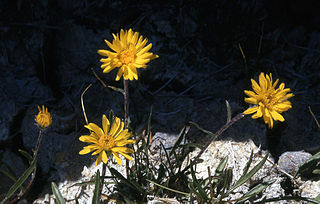
Pyrrocoma uniflora is a species of flowering plant in the family Asteraceae known by the common name plantain goldenweed. It is native to western North America from central Canada to California to Colorado, where it grows in several types of habitat, including forest and meadows with alkali soils, such as those near hot springs. It is a perennial herb growing up to 40 centimeters tall, the stems reddish and usually with a thin to thick coating of woolly fibers. The lance-shaped, toothed leaves are usually woolly, the largest near the base of the plant reaching up to 12 centimeters in length. The inflorescence is a single flower head or a cluster of a few heads, each lined with woolly phyllaries. The head contains yellow disc and ray florets. The fruit is an achene which may be over a centimeter long including its long pappus.
Packera bernardina is a rare species of flowering plant in the aster family known by the common name San Bernardino ragwort.

Packera cana is a species of flowering plant in the aster family known by the common name woolly groundsel. It is native to western and central North America, where it can be found in a wide array of habitat types at all elevations from grassland to the alpine climates of mountain peaks.

Packera greenei is a species of flowering plant in the aster family known by the common name flame ragwort. It is endemic to northern California, where it is known from the North Coast Ranges and southern Klamath Mountains. It is a resident of dry mountain scrub habitat, often on serpentine soils.
Solidago guiradonis is an uncommon species of goldenrod known by the common name Guirado goldenrod. It is native to the Central California Coast Ranges of central California, in southern San Benito and western Fresno Counties.
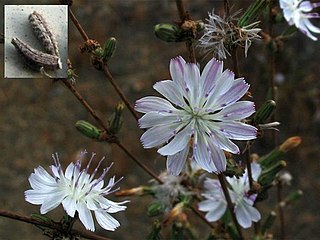
Stephanomeria diegensis is a species of flowering plant in the family Asteraceae known by the common name San Diego wirelettuce. It is native to the coastal hills and ranges of southern California and Baja California, where it grows in many types of open habitat. It evolved as a hybrid of Stephanomeria exigua and S. virgata. Furthermore, it is thought to be the result of homoploid hybrid speciation, which is uncommon. The plant is frequently misidentified as one of its parents, especially if older taxonomic keys are used. This is an erect annual herb easily exceeding two meters in height. Its slender stem has many spreading branches. The basal leaves are linear to lance-shaped and up to 10 centimeters long. The leaves wither early and are absent for most of the year, giving the plant a twiglike appearance. Leaves on the upper stem are small and reduced. The inflorescences are usually clusters of flower heads located at intervals on the stiff branches. Each head has a cylindrical base lined with phyllaries. These are often glandular. The head contains several ray florets, each with an elongated tube and a white or pink-tinged ligule measuring around a centimeter long. The fruit is a grooved achene tipped with a spreading cluster of long, plumelike pappus bristles.
Stephanomeria elata is a species of flowering plant in the family Asteraceae known by the common names Santa Barbara wirelettuce and Nuttall's wirelettuce. It is native to Oregon and California, where it grows in coastal and inland mountain ranges, including the Sierra Nevada. It can be found in many types of habitat. It is an annual herb producing a slender, erect stem often exceeding one meter in maximum height. It is hairy to hairless and often glandular. The leaves are mostly located in a basal rosette, the largest reaching 10 centimeters long. Smaller, much-reduced leaves occur farther up the stem. The leaves drop early, leaving the plant naked for most of the year. Flowers occur singly or in small clusters along the stiff branches. Each head contains up to 15 or 16 ray florets, each with an elongated tube and a pink ligule 6 or 7 millimeters long. The fruit is an achene tipped with a spreading cluster of long, plumelike pappus bristles.

Stephanomeria lactucina is a species of flowering plant in the family Asteraceae known by the common names lettuce wirelettuce and woodland wirelettuce. It is native to Oregon and California, where it grows in coastal and inland mountain ranges, including the Sierra Nevada. It can be found in many types of habitat, including coniferous forests. It is rhizomatous perennial herb producing a slender, erect stem reaching 30 to 60 centimeters in maximum height. The linear or lance-shaped leaves are up to 8 centimeters long and their edges are lined with widely spaced teeth. Solitary flower heads occur on erect peduncles. Each head contains up to 10 ray florets, each with an elongated tube and a fringed pink ligule roughly a centimeter long. The fruit is an achene tipped with a spreading cluster of long, plumelike pappus bristles.
Stephanomeria paniculata is a species of flowering plant in the family Asteraceae known by the common names tufted wirelettuce and stiff-branched wirelettuce. It is native to the northwestern United States, where it grows in many types of habitat, including disturbed areas. It is an annual or biennial herb producing a slender, erect stem with stiff, widely spreading branches toward the top. It is hairless. The leaves are mostly located in a basal rosette, the largest reaching 10 centimeters long. Smaller, linear leaves occur along the upper stem. Flower heads occur singly or in small clusters along the stiff branches. Each head contains 4 to 6 ray florets, each with an elongated tube and a pinkish or lavender ligule up to 1.4 centimeters long. The fruit is an achene tipped with a spreading cluster of long, white pappus bristles.
Stephanomeria parryi is a species of flowering plant in the family Asteraceae known by the common name Parry's wirelettuce. It is native to the southwestern United States, where it grows in many types of habitat, including many desert areas. It is a perennial herb growing from a thick root and producing one or more slender, upright stems up to about 40 centimeters tall. The green leaves are linear to lance-shaped with lobed edges and are up to 8 centimeters long near the base of the plant. Flower heads occur on the spreading branches. Each has up to 13 or 14 ray florets, each with an elongated tube and a whitish ligule up to 1.5 centimeters long. The fruit is an achene tipped with a spreading cluster of long, tan, plumelike pappus bristles.
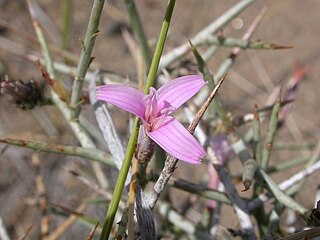
Pleiacanthus is a monotypic genus of flowering plants in the family Asteraceae containing the single species Pleiacanthus spinosus, which is known by the common name thorn skeletonweed, or thorny skeletonweed. It is native to the western United States from Montana and Idaho to southern California and Arizona, where it grows in many types of mostly dry habitat from deserts to mountains. It is a spindly subshrub producing several slender stems up to 40 or 50 centimeters tall from a woody caudex. The stems divide many times into short, rigid branches which narrow to sharp thorn-tips. The plant is mostly hairless except for brownish woolly tufts at the base and below the basal leaves. The leaves are small and linear on the lower stem, and reduced to scale-like growths on the upper branches. Flower heads occur near the ends of the branches. Each has a cylindrical base wrapped in one layer of phyllaries. The head contains 3 to 5 ray florets, each with an elongated tube and a pale to bright pink ligule. The fruit is an achene tipped with a cluster of pappus bristles which are not plumelike as are those of the Stephanomeria species with which this plant was once classified.
Trichostema parishii is a species of flowering plant in the mint family known by the common name Parish's bluecurls.
Trifolium andersonii is a species of clover known by the common names fiveleaf clover and Anderson's clover. It is native to the western United States, particularly the Great Basin and adjacent high mountain ranges, including the Sierra Nevada. It was named after Charles Lewis Anderson by Asa Gray.
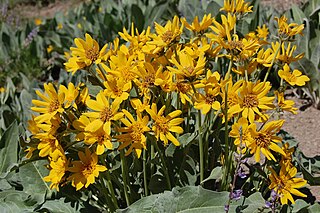
Wyethia mollis is a species of flowering plant in the family Asteraceae known by the common name woolly mule's ears. The plant is hairy to woolly in texture, sometimes losing its hairs with age.
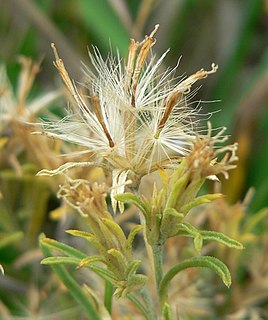
Ericameria parryi is a species of flowering plant in the aster family known by the common name Parry's rabbitbrush. It is native to much of the western United States.











